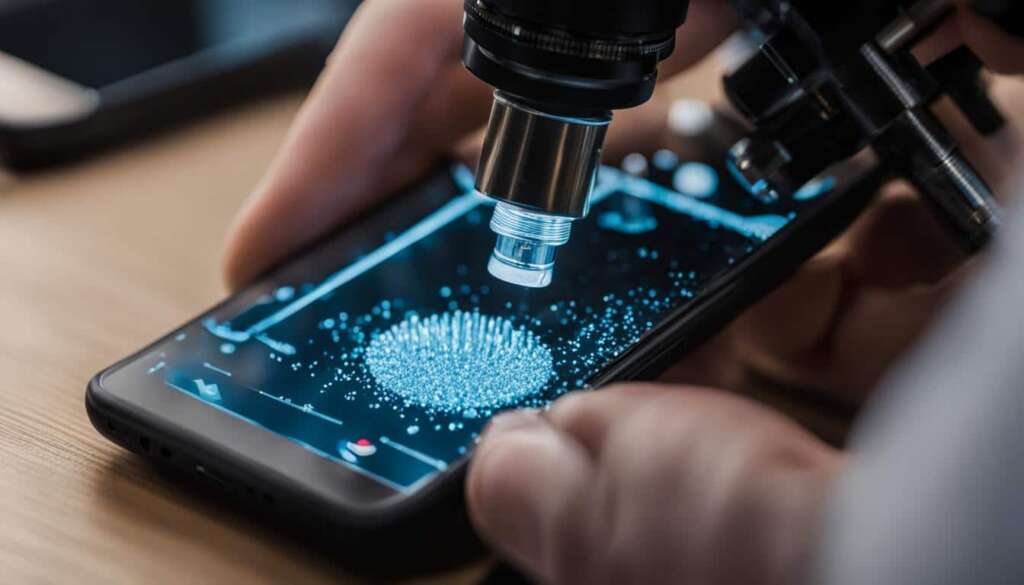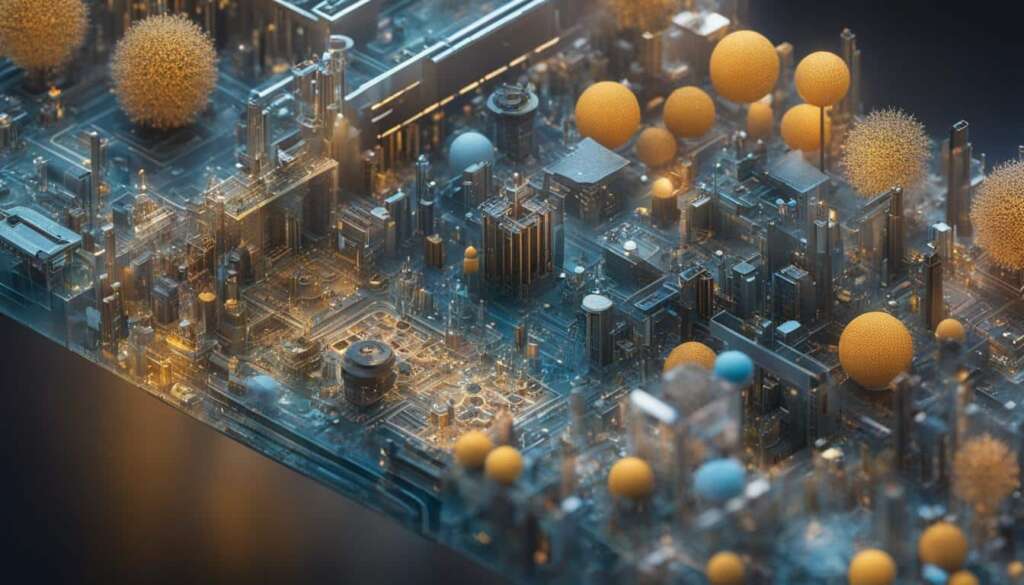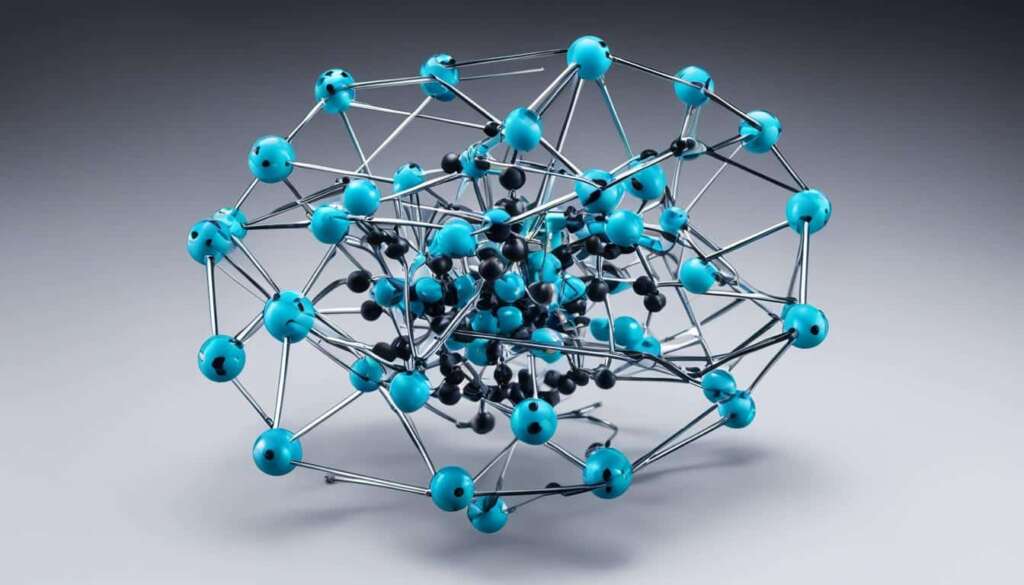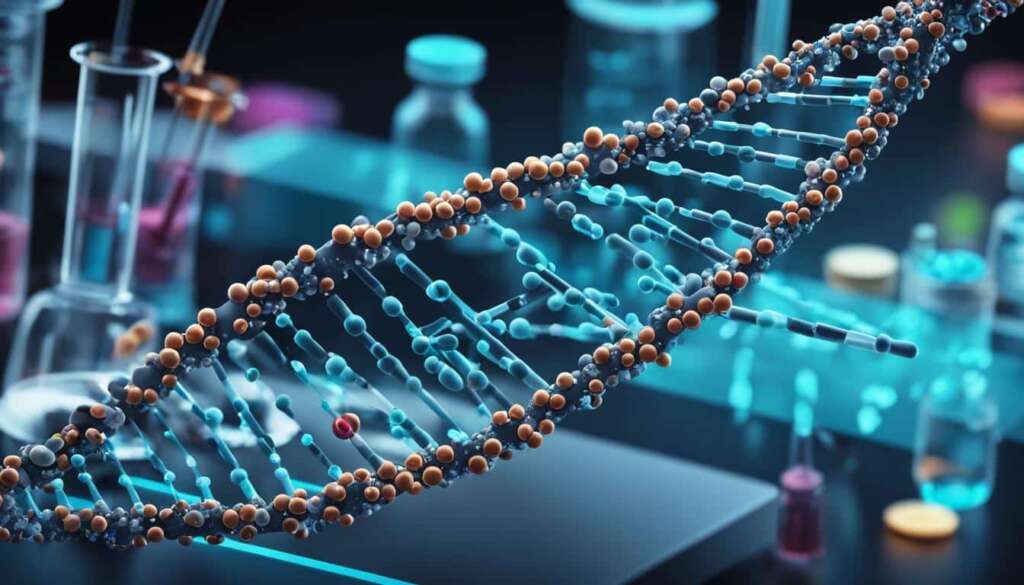Table of Contents
Nanotechnology, with its wide range of applications and profound impact on modern life, is revolutionizing various sectors, including healthcare and electronics. By manipulating matter on an atomic and molecular level, nanotechnology has paved the way for advancements in fields such as medicine, information technology, transportation, and more. In this article, we will delve into the versatile applications of nanotechnology and explore the incredible potential it holds for shaping our future.
Key Takeaways:
- Nanotechnology is revolutionizing various sectors, including healthcare and electronics.
- By manipulating matter on an atomic and molecular level, nanotechnology has paved the way for advancements in fields such as medicine, information technology, transportation, and more.
- Nanotechnology has the potential to shape our future and bring about significant changes in our everyday lives.
- The applications of nanotechnology are vast and diverse, spanning industries such as healthcare, electronics, information technology, energy, and more.
- As we continue to unlock the incredible capabilities of nanotechnology, it is crucial to address concerns related to health, safety, and the environment to ensure responsible and sustainable outcomes.
The Fascinating World of Nanoscience
Nanoscience is the branch of nanotechnology that focuses on studying and manipulating nanoparticles. These nanoparticles are collections of molecules or atoms measuring less than 100 nm in width. Nanoparticles possess unique properties that can differ from larger quantities of the same substance. These properties include enhanced strength, chemical reactivity, and electrical conductivity.
Nanoparticles have a wide range of applications in various fields, including healthcare, electronics, energy, and consumer products. Their small size and unique characteristics make them highly versatile and valuable in scientific research and technological advancements.
“Nanoparticles, with their extraordinary properties, have opened up a whole new world of possibilities in nanoscience. Their manipulation and control on the atomic and molecular scale have revolutionized the way we understand and interact with matter.”
For instance, in the field of healthcare, nanoparticles are used in drug delivery systems, diagnostic tools, and targeted therapies for diseases like cancer. In electronics, nanoparticles contribute to the development of smaller and more efficient devices, including transistors and memory storage. Energy and environmental science benefit from nanoparticles enhancing solar cells and filtration systems. Nanoscience has even influenced the production of everyday consumer products, such as stain-resistant fabrics and scratch-resistant coatings.
Overall, nanoscience plays a vital role in unlocking the potential of nanotechnology and driving innovation across various industries. Researchers continue to explore the properties of nanoparticles and their applications, paving the way for a more technologically advanced future.
Nanotechnology in Everyday Consumer Products
Nanotechnology has revolutionized the production of everyday consumer products, bringing numerous benefits to our daily lives. Through the incorporation of nanoparticles, these products offer enhanced functionalities and improved performance. Let’s explore some examples:
Silver Nanoparticles
Silver nanoparticles have been widely utilized for their antimicrobial properties. They are commonly found in various consumer goods, including:
- Hand washes
- Bandages
- Socks
Titanium Nanoparticles
Titanium nanoparticles play a crucial role in modern sunscreens, providing effective UV protection. By incorporating titanium nanoparticles, these sunscreens offer:
- Enhanced sun protection
- Reduced risk of skin damage from harmful UV rays
Carbon Nanotubes
Carbon nanotubes are incredibly strong, making them ideal for applications requiring high durability. They are commonly used in sports equipment, such as:
- Bicycles
- Tennis rackets
By utilizing carbon nanotubes, these products offer improved strength, durability, and performance.
Improved Electronic Devices
Nanotechnology has significantly enhanced electronic devices, leading to more efficient and advanced consumer products. Display screens, electronic devices, and memory chips incorporate nanoparticles to:
- Enhance screen resolution and color accuracy
- Improve device performance
- Increase memory capacity
As a result, consumers can enjoy devices with better visuals, faster processing speeds, and increased storage capabilities.
Nanocomposite Plastic Bottles
Another notable application of nanotechnology is the use of nanocomposite plastic bottles. These bottles have been developed to provide resistance to carbonated beverages going flat, contributing to a longer shelf life and a better consumer experience.

| Consumer Product | Nanoparticle | Benefits |
|---|---|---|
| Hand washes | Silver nanoparticles | Antimicrobial properties |
| Bandages | Silver nanoparticles | Antimicrobial properties |
| Socks | Silver nanoparticles | Antimicrobial properties |
| Sunscreens | Titanium nanoparticles | UV protection |
| Bicycles | Carbon nanotubes | Enhanced strength and durability |
| Tennis rackets | Carbon nanotubes | Enhanced strength and durability |
| Display screens | Nanoparticles | Improved visuals |
| Electronic devices | Nanoparticles | Faster processing speed and increased storage capacity |
| Nanocomposite plastic bottles | Nanoparticles | Resistance to carbonated beverages going flat |
Nanotechnology in Information Storage
Nanotechnology offers exciting possibilities for information storage beyond traditional microprocessors and physical storage devices. By manipulating matter on a molecular level, nanotechnology enables researchers to explore alternative methods of storing vast amounts of data. One such method is the utilization of DNA in a process called Nuclear Acid Memory (NAM).
In recent breakthroughs, scientists have demonstrated the ability to store and retrieve archival-quality music and images in DNA form. This is a remarkable development as DNA is highly durable and takes up very little space. It holds the potential to revolutionize information storage and preservation in the future.
The Advantages of DNA Storage
Using DNA as a storage medium offers several key advantages:
- Immense Storage Capacity: DNA molecules can store a massive amount of data. A single gram of DNA has the potential to hold over 200 petabytes (200 million gigabytes) of information, making it vastly superior to traditional storage methods.
- Durability: DNA is incredibly stable and can withstand harsh environmental conditions, including extreme temperatures and radiation. This ensures the longevity and integrity of stored data.
- Compactness: DNA’s compact nature allows for efficient use of physical space. Storing large amounts of information in a relatively small volume is critical in today’s data-driven world.
- Energy Efficiency: DNA storage requires significantly less power compared to traditional storage devices. This energy efficiency factor is crucial for sustainable and environmentally friendly information storage solutions.
It is important to note that while DNA storage shows great promise, there are still challenges to overcome, such as the cost and complexity of the storage process. However, ongoing research and advancements in nanotechnology continue to address these obstacles and pave the way for practical implementation.
Overall, nanotechnology, specifically in the realm of DNA storage, holds tremendous potential for transforming the way we store and access information. As researchers delve deeper into the possibilities of Nuclear Acid Memory, we can anticipate a future where information can be stored with unprecedented capacity, durability, and efficiency.
| Advantages of DNA Storage |
|---|
| Immense Storage Capacity |
| Durability |
| Compactness |
| Energy Efficiency |
Nanotechnology in Various Industries
Nanotechnology is playing a significant role in driving advancements across various industries, including information technology, homeland security, medicine, transportation, energy, food safety, and environmental science. This revolutionary technology allows for the creation of materials that are stronger, lighter, more durable, and more reactive. By incorporating nanoscale additives and surface treatments, the properties of fabrics, coatings, and materials used in automotive and aerospace products can be enhanced.
In the field of information technology, nanotechnology has revolutionized the development of smaller, faster, and more energy-efficient electronic devices. It has enabled the production of more powerful transistors, the building blocks of modern computing, leading to significant advancements in computing power and data storage.
Furthermore, nanotechnology has made significant contributions to homeland security, allowing for the development of state-of-the-art sensors and detection systems. Nanosensors can detect minute traces of explosives, chemical agents, and biological pathogens, thereby enhancing security measures and protecting public safety.
In medicine, nanotechnology has opened up new frontiers in diagnostics and treatment. Nanoparticles are being used as probes for the early detection of diseases, enabling rapid and accurate diagnoses. Additionally, nanotechnology offers targeted drug delivery systems, improving the efficacy of therapeutic treatments while minimizing side effects on healthy tissues.
The transportation industry has also benefited from nanotechnology. By incorporating nanomaterials in vehicle components, such as lightweight and durable nanocomposites, fuel efficiency can be improved. Nanocoatings on car surfaces provide protection against scratches, rust, and environmental contaminants, enhancing the longevity and appearance of vehicles.
Energy production and storage have been revolutionized by nanotechnology as well. Nanomaterials are being used to enhance the efficiency of solar cells, enabling the conversion of sunlight into electricity more effectively. Additionally, nanotechnology plays a crucial role in the development of advanced energy storage devices, such as high-capacity batteries and supercapacitors.
Food safety is another area where nanotechnology has made a significant impact. Nanosensors can detect contaminants in food products, ensuring their safety and quality. Nanomaterials are also used in food packaging to enhance freshness, prevent spoilage, and extend shelf life.
Finally, nanotechnology is playing a crucial role in environmental science. Nanoscale catalysts are being used to improve the efficiency of chemical processes, reducing energy consumption and environmental impact. Nanomaterials are also being explored for water purification technologies, offering innovative solutions to address global water scarcity challenges.
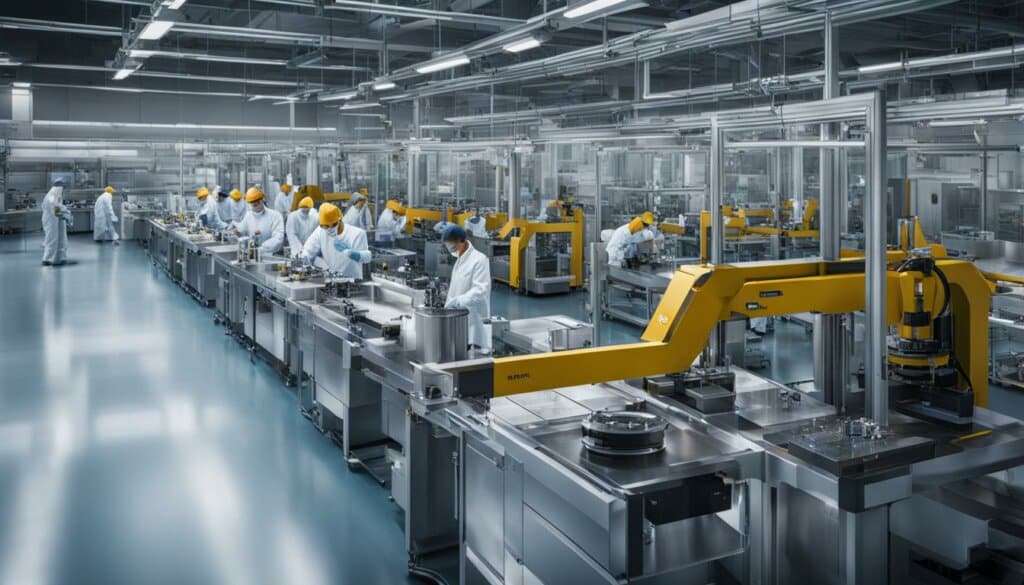
The potential applications of nanotechnology in various industries are vast and diverse. As researchers continue to explore and innovate in this field, we can expect even more groundbreaking advancements that will shape the future of technology and industry.
Nanotechnology in Healthcare and Medicine
Nanotechnology is revolutionizing healthcare and medicine through the field of nanomedicine. It offers precise solutions for disease prevention, diagnosis, and treatment. Nanoparticles are used as probes for the detection of targeted sequences of nucleic acids in diagnostics. They also show potential as targeted therapies for cancer and other diseases, delivering medication directly to cells while minimizing damage to healthy tissue. Nanotechnology has advanced imaging techniques, enabling earlier diagnosis and more individualized treatment options. The possibilities for nanotechnology in healthcare are vast and hold great promise for the future.
Nanotechnology in Electronics and IT
Nanotechnology has played a significant role in advancing electronics and information technology. Its applications have led to smaller and more powerful transistors, which are the basic switches that enable modern computing. By manipulating matter on an atomic and molecular level, nanotechnology has revolutionized the field of electronics, allowing for the development of cutting-edge technologies that were once unimaginable.
One area where nanotechnology has made a profound impact is in memory storage. It has enabled the development of magnetic random access memory (MRAM), a technology that allows for quick data saving and resume-play features in computers. MRAM has the potential to replace conventional memory storage methods, offering faster and more reliable data storage capabilities.
Furthermore, nanotechnology has contributed to the production of high-resolution displays using quantum dots. Quantum dots are nanoscale semiconductor crystals that emit light of different colors based on their size. By incorporating quantum dots into display screens, electronics manufacturers have been able to achieve more vibrant and lifelike colors, as well as improved energy efficiency.
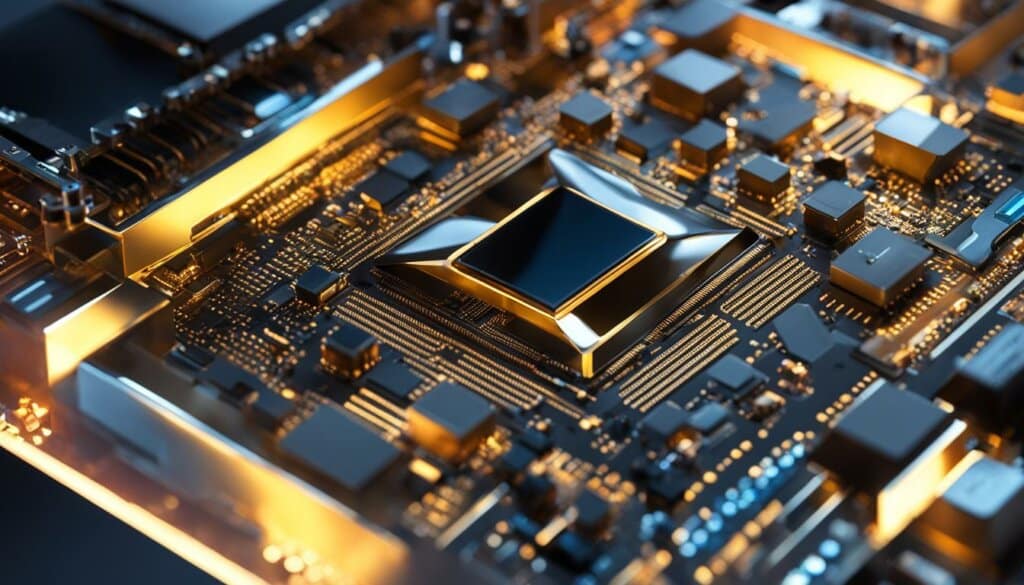
The versatility of nanotechnology has also paved the way for flexible, bendable, and wearable electronics. These advancements have opened up new possibilities in various sectors, ranging from healthcare and sports to fashion and entertainment. Flexible electronics, such as flexible displays and sensors, offer greater convenience and portability, while wearable electronics, such as smartwatches and fitness trackers, have become indispensable in our daily lives.
In conclusion, nanotechnology has revolutionized the world of electronics and IT. It has enabled the development of smaller and more powerful transistors, improved memory storage capabilities, and enhanced display technologies. Additionally, nanotechnology has paved the way for flexible and wearable electronics, shaping the future of technology. With ongoing research and advancements, the potential applications of nanotechnology in the field of electronics are vast and continue to expand.
Nanotechnology in Everyday Products
Nanotechnology has already infiltrated numerous everyday products, enhancing their functionalities and improving our daily lives. By harnessing the power of nanoparticles, these products offer unique benefits that were once unimaginable. Let’s explore some of the fascinating ways nanotechnology is integrated into a variety of everyday items.
Sunscreen
One of the most common applications of nanotechnology in everyday life is sunscreen. Nanoparticles, such as zinc oxide or titanium dioxide, are used to provide effective protection against harmful UV rays. These nanoparticles act as a barrier, shielding our skin from sun damage. The use of nanotechnology allows for sunscreens that are transparent, non-greasy, and easily applicable, ensuring maximum safety and sun protection.
Clothing
Nanotechnology has revolutionized the textile industry, making our clothes more functional and durable. Fabrics infused with nanoparticles exhibit remarkable properties, such as waterproofing and stain resistance. This means that spills and stains no longer pose a significant threat to our favorite garments. Additionally, nanotechnology enables the development of fabrics with enhanced breathability, moisture-wicking, and antimicrobial properties, ensuring greater comfort and hygiene.
Furniture
Nanotechnology has also made its way into the furniture industry, improving both the aesthetics and functionality of our household items. Nanocoatings are used to protect furniture from stains, scratches, and fading. These coatings add an extra layer of durability and make furniture less flammable, ensuring a safer living environment. By integrating nanotechnology, furniture becomes more resistant to wear and tear, prolonging its lifespan.
Adhesives
Traditional adhesives often fail under extreme temperatures or lose their effectiveness over time. However, nanotechnology has brought substantial improvements to adhesive technologies. Nanoparticles are added to adhesives, enhancing their strength, flexibility, and resistance to heat. This means that adhesives using nanotechnology are better equipped to withstand the demands of various industries, from electronics to aerospace, ensuring more reliable bonding in critical applications.
Car Coatings
Nanotechnology has transformed the automotive industry by introducing advanced coatings that provide superior protection for cars. Nanocoatings are applied to the exterior paintwork, creating a barrier against bird droppings, scratches, and UV rays. These coatings also make cleaning easier, ensuring that cars maintain their pristine appearance for longer. In addition, nanotechnology has extended its benefits to car interiors, where nanocoatings protect upholstery from stains and spills, making them easier to clean and maintain.
Tennis Balls
Nanotechnology has revolutionized the world of sports, including the production of tennis balls. By incorporating nanoparticles, tennis balls become more durable and offer improved bounce, resulting in better performance and longer-lasting play. The application of nanotechnology enables the production of tennis balls that stay in optimal condition for extended periods, ultimately enhancing the overall experience for players.
Computers
The development of advanced computer processors owes much to nanotechnology. By utilizing nanoscale technologies, engineers have been able to create smaller, faster, and more energy-efficient computer components. Nanoscale transistors and memory storage devices have paved the way for remarkable advancements in computing power, enabling complex tasks to be performed with lightning speed. Nanotechnology continues to drive innovation in the computer industry, shaping the future of technology.
Nanotechnology has revolutionized the everyday products we rely on, from sunscreens that protect our skin to furniture coatings that ensure a longer lifespan. As nanotechnology continues to advance, we can expect even more remarkable applications in a wide range of industries, enhancing our lives and shaping the future.
Conclusion
Nanotechnology has had a profound impact on various aspects of modern life, bringing about transformative changes in industries ranging from healthcare to electronics. The applications of nanotechnology continue to expand, leading to improved efficiency and performance of everyday products and advancements in numerous sectors. With endless possibilities and constant innovations, nanotechnology holds immense potential for the future.
As researchers delve deeper into this transformative technology, it is crucial to address concerns related to health, safety, and the environment. Responsible and sustainable practices must be adopted to ensure that the remarkable capabilities of nanotechnology are harnessed for the benefit of society.
The future of nanotechnology looks promising, with ongoing advancements and discoveries. As we unlock the full potential of nanotechnology, we can expect a brighter and more technologically advanced future. The impact of nanotechnology on our lives will continue to grow, shaping industries, improving everyday products, and driving innovation. It is through harnessing the power of nanotechnology that we can create a transformative and sustainable future.
FAQ
What is nanotechnology?
Nanotechnology is a field that involves manipulating matter at the atomic and molecular level. It has applications in various sectors and is revolutionizing modern life.
What is nanoscience?
Nanoscience is a branch of nanotechnology that focuses on studying and manipulating nanoparticles, which are collections of molecules or atoms measuring less than 100 nm in width.
What are the applications of nanotechnology in everyday consumer products?
Nanotechnology is already present in everyday consumer products such as hand washes, bandages, socks, sunscreens, sports equipment, display screens, electronic devices, memory chips, and plastic bottles.
How is nanotechnology used in information storage?
Nanotechnology offers exciting possibilities for information storage beyond traditional microprocessors and physical storage devices. Researchers are exploring the use of DNA in a process called Nuclear Acid Memory (NAM) to store vast amounts of information.
Which industries are benefiting from nanotechnology?
Nanotechnology is making significant contributions to industries such as information technology, homeland security, medicine, transportation, energy, food safety, and environmental science.
How is nanotechnology revolutionizing healthcare?
Nanotechnology is revolutionizing healthcare through the field of nanomedicine. It offers precise solutions for disease prevention, diagnosis, and treatment, including targeted therapies for cancer and advanced imaging techniques.
What is the role of nanotechnology in electronics and information technology?
Nanotechnology has played a significant role in advancing electronics and IT, leading to smaller and more powerful transistors, magnetic random access memory (MRAM), high-resolution displays using quantum dots, and flexible and wearable electronics.
What everyday products use nanotechnology?
Nanotechnology is present in many everyday products such as sunscreens, clothing, furniture, adhesives, car coatings, tennis balls, and computers.
What impact does nanotechnology have on modern life?
Nanotechnology has brought transformative changes to various aspects of modern life, improving the efficiency and performance of products and contributing to advancements in numerous industries. Its potential for the future is immense.

